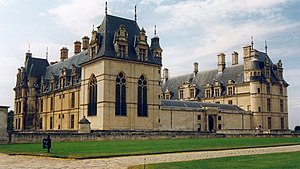Edict of Écouen
The Edict of Écouen , French L'édit d'Écouen , was issued on June 2, 1559 by the French King Henry II at Écouen Castle . Its aim was the strict suppression of the Calvinist heresy . It took place before the wars of religion of the 16th century , but must undoubtedly have made a significant contribution to their outbreak.
Historical framework
The Reformation only began to really invade France under the reign of Henry II (1547 to 1559). Henry II was a strict Catholic and therefore quickly took measures to curb the spread of the new religion. For example, between 1549 and 1551, the Edict of Paris and the Edict of Châteaubriant extended the legal powers of Catholic judges in order to be able to try Protestant heretics. In addition, the Edict of Compiègne came on July 24, 1557 , which intensified the repression by public courts. This also affected Catholics who supported or even hosted Protestants. Nevertheless, the Inquisition was not introduced in the kingdom, since Henry II. With the Pope Julius III. was in conflict.
Despite persecution and increasing heresy trials, Protestantism continued to spread in France, including among the nobility. In September 1557, riots broke out on Rue Saint-Jacques in Paris among an angry crowd at a gathering of Reformed people. An assassination attempt was made on Heinrich II. However, it could never be proven that Protestants were behind the attack, since the assassin was killed on the spot.
edict
At the height of the religious turmoil, the king, who stayed with his advisor Anne de Montmorency at Écouen Castle , issued the Edict of Écouen on June 2, 1559. Its central point was the demand that all revolting or fleeing Protestants be rendered harmless without trial. The edict thus left the legal framework that had been respected in the previous edicts.
In addition to the edict, Henry II wrote several documents, the letters from Écouen (French lettres d'Écouen ). In them he assigned certain dignitaries to persecute the Reformed.
This procedure outraged part of the parliament , some of which had already transferred to the Reformation. On June 10, 1559, the king went to the plenary session of the Parlement de Paris to register his edict by means of a lit de justice . Several parliamentarians protested in public. Heinrich II then had the parliamentarians in question incarcerated. With the exception of Anne du Bourg , an ardent advocate of Calvinism, most were released because they revoked. Anne de Bourg was hanged on December 23, 1559 at the instigation of François de Guise and burned at the stake on the Place de Grève .
Effects
Both the Edict of Écouen and the execution of Anne du Bourg were unequivocal preludes of the Huguenot Wars .
In general, the royal edicts were difficult to implement due to the weaknesses in administration and jurisdiction of a less centralized kingdom. In addition, officials already devoted to the Reformation were unwilling to apply the royal decrees of their own free will.
Since the previous edicts showed very little success, it is not surprising that under Henry II an increasingly brutal persecution was initiated.
Only 5 weeks after the edict was issued, Heinrich II died on July 10, 1559 of serious injuries sustained during a toast . He was succeeded by his son Francis II , who in turn only ruled for a short time until 1560. Katharina von Medici then reigned for her 10-year-old son Karl IX.


